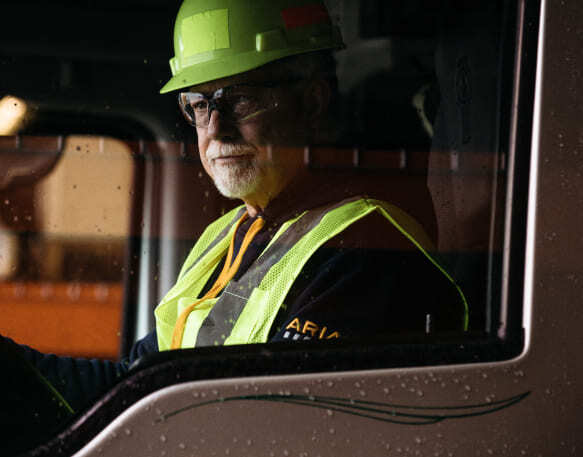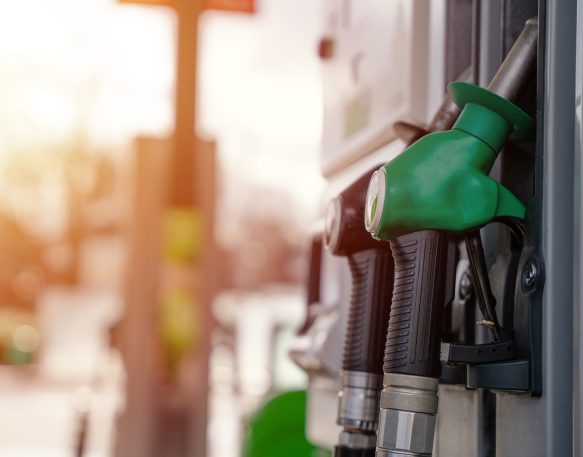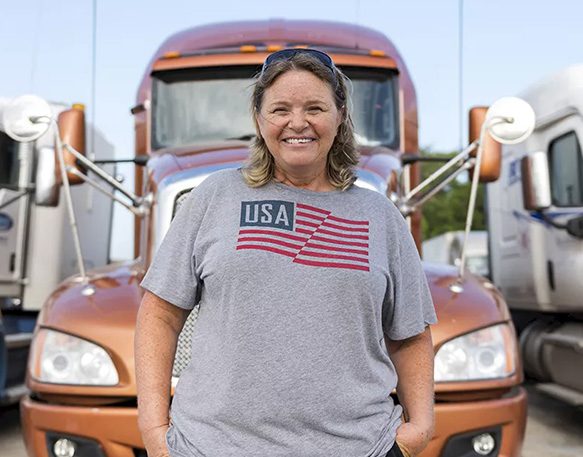If you’re just starting your trucking business, setting yourself up for success from the beginning is crucial. A key factor in achieving this is understanding how your location and route choices will impact your operations. One of the fundamental questions you’ll need to answer is whether you’ll be engaged in interstate or intrastate trucking. These two classifications have significant differences that can affect everything from the type of commercial driver’s license (CDL) you need to the regulations you must follow. Navigating the requirements for interstate vs. intrastate trucking is essential for compliance, efficiency, and growth.
In this guide, we’ll explore the key differences between interstate vs. intrastate trucking to help you make informed decisions that align with your business goals and legal obligations.
What is the difference between interstate and intrastate?
The main difference between interstate vs. intrastate trucking is that interstate means you are legally permitted to cross state lines or national borders while transporting freight. On the other hand, intrastate means you are only delivering freight within a single state.
That’s the basic distinction between interstate vs. intrastate trucking, but let’s dive a little deeper into what each type of trucking entails and discuss the ways they differ.
Interstate vs. intrastate CDL: What’s the difference?
When it comes to commercial driving, understanding the distinction between an interstate and intrastate CDL is essential for compliance and successful operations. The type of CDL you need depends on where you plan to operate your trucking business and the nature of your hauls. Here’s how the two differ:
- Interstate CDL: An interstate CDL is required for drivers who transport goods or passengers across state lines or internationally. This includes any long-distance route that involves crossing state borders, even if it’s just a brief segment of the journey. Interstate CDL holders must adhere to federal regulations set by the Federal Motor Carrier Safety Administration (FMCSA), which include stricter qualifications for health and safety.
- Intrastate CDL: An intrastate CDL is used for drivers who operate solely within a single state’s boundaries. Intrastate drivers must follow state-specific regulations, which may have different age, medical, and driving hour requirements compared to federal standards. While the rules are often less stringent, compliance with state regulations is still mandatory.
Why is it important to know the difference between interstate and intrastate?
Knowing the difference between interstate vs. intrastate trucking is important because the requirements for each vary quite a bit. Failing to comply with the specific federal and state regulations for both types of travel can lead to costly fines, or even force you to halt operations until the necessary adjustments are made.
These disruptions not only drain time and money but can also pose serious risks to your business. Knowing upfront whether your operations will fall under interstate or intrastate trucking gives you a clear path to compliance and keeps things running smoothly.
It’s also important to note that some freight might appear to be intrastate but is actually classified as interstate. For example, if a shipment crosses state lines at any point during its journey—even if you only handle the in-state portion—it’s considered interstate freight. Likewise, crossing state borders to complete a delivery within the same state still qualifies as interstate trucking. Being aware of these nuances helps you avoid regulatory pitfalls and ensures you stay on the right side of the law.
Staying compliant should be a top priority for any carrier or owner-operator, making it crucial to understand the distinction between interstate vs. intrastate freight.
What is interstate trucking?
As we mentioned earlier, the key characteristic of interstate trucking is that it involves crossing state lines or national borders, including between the U.S., Canada, and Mexico. Because of this, interstate loads are often long-haul, which is something to consider when deciding if this type of trucking suits your needs.
It’s important for carriers and owner-operators to understand what counts as interstate trucking. For example, even if you’re driving within one state, if the freight has crossed state lines before reaching you—or will after—it’s considered interstate. This means you’ll need the proper licensing to comply with interstate regulations.
Common truck types used in interstate trucking include:
- Refrigerated trailers (Reefer trucks)
- Flatbed trailers
- Dry vans
- Tankers
- Semi-trucks
For most small carriers and independent owner-operators, interstate trucking is usually a better fit than intrastate trucking, offering many advantages that are lost with intrastate trucking. We’ll go over some of the specific requirements for interstate trucking shortly.
What is intrastate trucking?
Intrastate trucking is a bit more straightforward than interstate—it simply means that freight is picked up and delivered within the same state. Examples of trucks that require CDLs but only operate within state lines include:
- Tow trucks
- Garbage trucks
- Dump trucks
- Concrete mixing trucks
- Box trucks
Intrastate loads are typically handled by companies and carriers rather than independent owner-operators. Businesses running short-haul routes with these types of trucks don’t have to follow the same FMCSA regulations that apply to long-haul trucking, making it a bit easier to get started in intrastate trucking if you’re focusing on shorter routes.
Intrastate vs. interstate operating authority
The key difference between intrastate vs. interstate trucking lies in the requirements for obtaining operating authority.
- Interstate trucking: If you’re hauling freight across state lines, you’ll likely need a US DOT number from the Department of Transportation, as outlined by the FMCSA. This applies if you transport hazardous materials, operate vehicles over 10,001 pounds, or carry more than 8 passengers for compensation across state lines. You must also register under the Unified Carrier Registration (UCR) Act and comply with the International Fuel Tax Agreement (IFTA) and International Registration Plan (IRP) for tax and registration purposes.
- Intrastate trucking: While intrastate trucking doesn’t require federal operating authority, you’ll still need to meet state-specific regulations. Many states mandate a DOT number for intrastate operations, and requirements vary by state. Intrastate carriers also need to comply with IFTA and IRP, and in some states—including Connecticut, Indiana, and Pennsylvania—a separate intrastate fuel permit is required.
Interstate vs. intrastate insurance
Insurance is another main area where intrastate vs. interstate trucking differs.
For interstate insurance, carriers and owner-operators who haul freight across state lines and national borders must meet the minimum coverage limits established by the FMCSA. Coverage minimums will change based on factors like type of freight and truck weight. Some examples listed by the FMCSA include:
- Non-hazardous materials transported in a vehicle weighing less than 10,001 pounds: $300,000
- Non-hazardous materials transported in vehicle weight more than 10,0001 pounds: $750,000
- Hazardous material moved by private carriers and for-hire: $5 million
It’s also important to recognize that, while these are the minimums presented by the FMCSA, many shippers and carriers may require you to have at least $1 million worth of coverage.
On the other hand, insurance requirements for intrastate trucking are set by each individual state. Some states follow FMCSA guidelines, while others have their own rules. Be sure to check the specific regulations in your state to make sure you’re compliant.
The similarities between interstate vs. intrastate
While there are many differences between interstate and intrastate trucking, there are also some key similarities that all carriers and owner-operators need to follow, whether they’re crossing state lines or staying within one state. Let’s take a closer look:
- CDL requirements: Whether you’re pursuing an interstate or intrastate CDL, you’ll still need a commercial driver’s license to operate legally. The type of CDL may vary depending on where you drive, but the basic process of obtaining a CDL involves passing written and skills tests, meeting age requirements, and fulfilling any specific endorsements for specialized cargo.
- Drug and alcohol testing: All truck drivers must comply with federal drug and alcohol testing regulations. This includes pre-employment testing, random testing, and post-accident testing.
- Commercial trucker insurance: Although the specific coverage requirements differ, all carriers must have commercial insurance. Whether interstate or intrastate, trucking businesses need adequate coverage to protect against liabilities.
- Hazardous materials training: For those transporting hazardous materials, specialized training is mandatory for both interstate and intrastate trucking.
Is interstate or intrastate trucking right for you?
Choosing between interstate and intrastate trucking depends on your business goals, but many small carriers and owner-operators find that interstate trucking has more to offer. With interstate trucking, you’ll have access to a wider range of opportunities, including more diverse freight options and expanded partnerships with shippers and brokers. This added flexibility can really help your business grow, as you won’t be limited by state lines when looking for the right load.
Another benefit of interstate trucking is that it opens more doors—so you won’t have to miss out on a great opportunity because of licensing restrictions. Plus, as an interstate trucker, you can still take on intrastate loads whenever you want, giving you the best of both worlds.
Set your trucking business up for success
Understanding the differences and similarities between interstate and intrastate trucking is essential for building a successful trucking business. From selecting the right CDL to meeting insurance requirements and staying compliant with regulations, each choice impacts your overall operations.
While intrastate trucking may be simpler for some, many small carriers and owner-operators find interstate trucking offers greater growth potential and flexibility. No matter which path you choose, making informed decisions will be key to your long-term success.
Carrier services from DAT can set your business apart
No matter if you choose interstate or intrastate trucking, DAT has the tools and expertise to help you succeed. From simplifying the paperwork process to finding the right loads and tracking your freight, we’re here to support every step of your journey.
Get your business up and running with ease and unlock more opportunities on the road. Explore DAT’s carrier services today and start building your trucking business with confidence.




